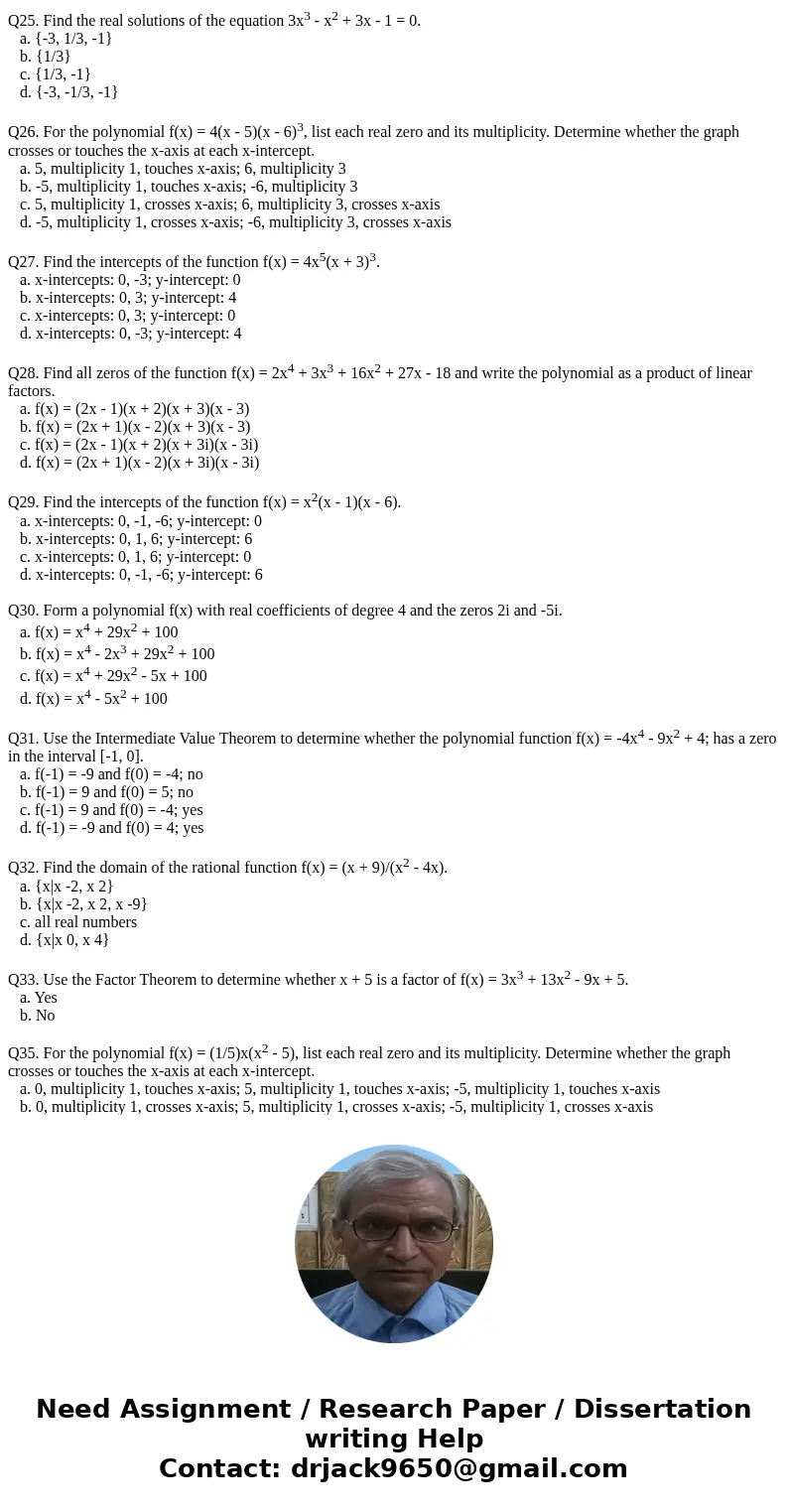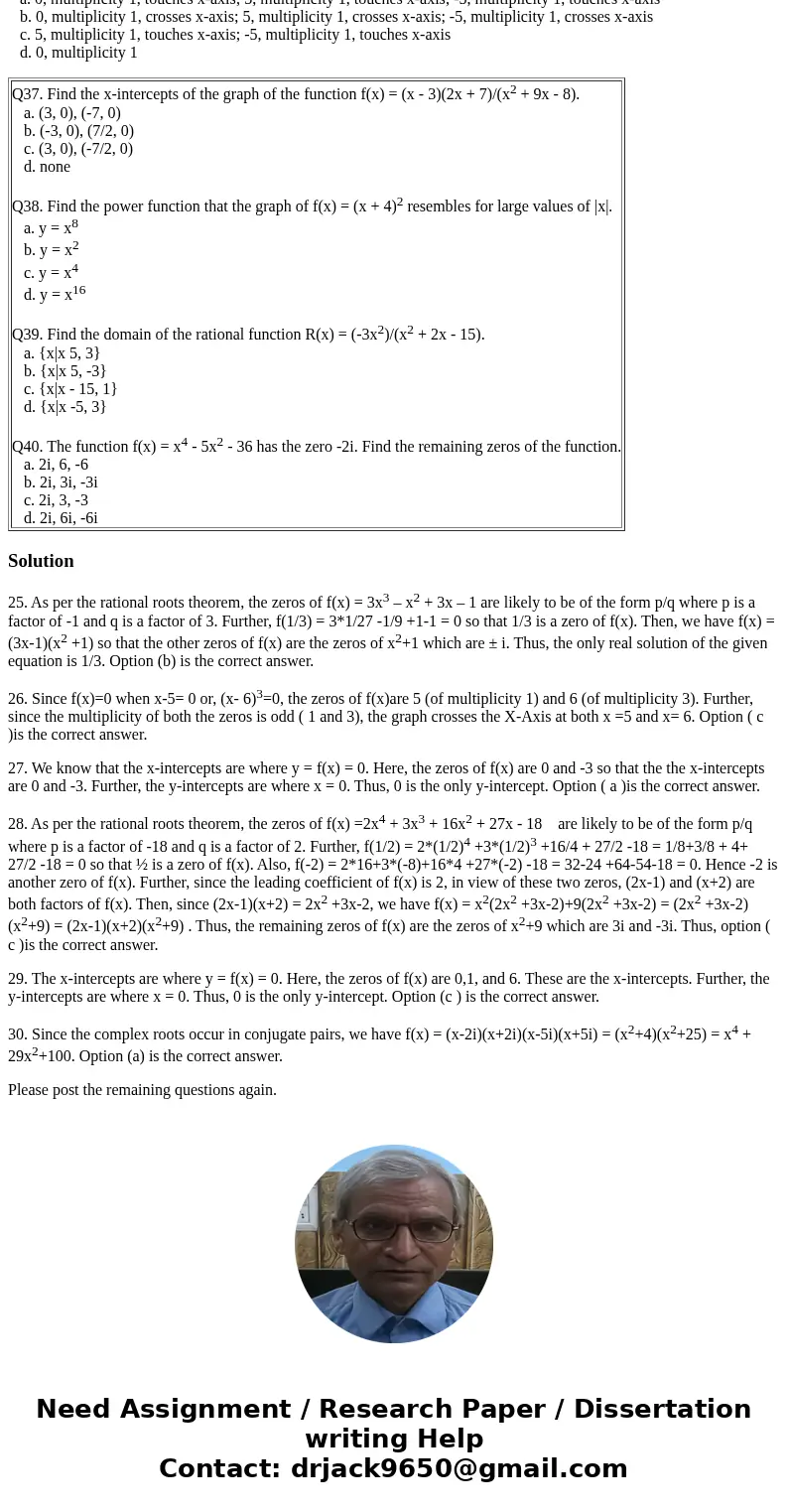Q25 Find the real solutions of the equation 3x3 x2 3x 1
Q25. Find the real solutions of the equation 3x3 - x2 + 3x - 1 = 0.
a. {-3, 1/3, -1}
b. {1/3}
c. {1/3, -1}
d. {-3, -1/3, -1}
Q26. For the polynomial f(x) = 4(x - 5)(x - 6)3, list each real zero and its multiplicity. Determine whether the graph crosses or touches the x-axis at each x-intercept.
a. 5, multiplicity 1, touches x-axis; 6, multiplicity 3
b. -5, multiplicity 1, touches x-axis; -6, multiplicity 3
c. 5, multiplicity 1, crosses x-axis; 6, multiplicity 3, crosses x-axis
d. -5, multiplicity 1, crosses x-axis; -6, multiplicity 3, crosses x-axis
Q27. Find the intercepts of the function f(x) = 4x5(x + 3)3.
a. x-intercepts: 0, -3; y-intercept: 0
b. x-intercepts: 0, 3; y-intercept: 4
c. x-intercepts: 0, 3; y-intercept: 0
d. x-intercepts: 0, -3; y-intercept: 4
Q28. Find all zeros of the function f(x) = 2x4 + 3x3 + 16x2 + 27x - 18 and write the polynomial as a product of linear factors.
a. f(x) = (2x - 1)(x + 2)(x + 3)(x - 3)
b. f(x) = (2x + 1)(x - 2)(x + 3)(x - 3)
c. f(x) = (2x - 1)(x + 2)(x + 3i)(x - 3i)
d. f(x) = (2x + 1)(x - 2)(x + 3i)(x - 3i)
Q29. Find the intercepts of the function f(x) = x2(x - 1)(x - 6).
a. x-intercepts: 0, -1, -6; y-intercept: 0
b. x-intercepts: 0, 1, 6; y-intercept: 6
c. x-intercepts: 0, 1, 6; y-intercept: 0
d. x-intercepts: 0, -1, -6; y-intercept: 6
Q30. Form a polynomial f(x) with real coefficients of degree 4 and the zeros 2i and -5i.
a. f(x) = x4 + 29x2 + 100
b. f(x) = x4 - 2x3 + 29x2 + 100
c. f(x) = x4 + 29x2 - 5x + 100
d. f(x) = x4 - 5x2 + 100
Q31. Use the Intermediate Value Theorem to determine whether the polynomial function f(x) = -4x4 - 9x2 + 4; has a zero in the interval [-1, 0].
a. f(-1) = -9 and f(0) = -4; no
b. f(-1) = 9 and f(0) = 5; no
c. f(-1) = 9 and f(0) = -4; yes
d. f(-1) = -9 and f(0) = 4; yes
Q32. Find the domain of the rational function f(x) = (x + 9)/(x2 - 4x).
a. {x|x -2, x 2}
b. {x|x -2, x 2, x -9}
c. all real numbers
d. {x|x 0, x 4}
Q33. Use the Factor Theorem to determine whether x + 5 is a factor of f(x) = 3x3 + 13x2 - 9x + 5.
a. Yes
b. No
Q35. For the polynomial f(x) = (1/5)x(x2 - 5), list each real zero and its multiplicity. Determine whether the graph crosses or touches the x-axis at each x-intercept.
a. 0, multiplicity 1, touches x-axis; 5, multiplicity 1, touches x-axis; -5, multiplicity 1, touches x-axis
b. 0, multiplicity 1, crosses x-axis; 5, multiplicity 1, crosses x-axis; -5, multiplicity 1, crosses x-axis
c. 5, multiplicity 1, touches x-axis; -5, multiplicity 1, touches x-axis
d. 0, multiplicity 1
| Q37. Find the x-intercepts of the graph of the function f(x) = (x - 3)(2x + 7)/(x2 + 9x - 8). a. (3, 0), (-7, 0) b. (-3, 0), (7/2, 0) c. (3, 0), (-7/2, 0) d. none Q38. Find the power function that the graph of f(x) = (x + 4)2 resembles for large values of |x|. a. y = x8 b. y = x2 c. y = x4 d. y = x16 Q39. Find the domain of the rational function R(x) = (-3x2)/(x2 + 2x - 15). a. {x|x 5, 3} b. {x|x 5, -3} c. {x|x - 15, 1} d. {x|x -5, 3} Q40. The function f(x) = x4 - 5x2 - 36 has the zero -2i. Find the remaining zeros of the function. a. 2i, 6, -6 b. 2i, 3i, -3i c. 2i, 3, -3 d. 2i, 6i, -6i |
Solution
25. As per the rational roots theorem, the zeros of f(x) = 3x3 – x2 + 3x – 1 are likely to be of the form p/q where p is a factor of -1 and q is a factor of 3. Further, f(1/3) = 3*1/27 -1/9 +1-1 = 0 so that 1/3 is a zero of f(x). Then, we have f(x) =(3x-1)(x2 +1) so that the other zeros of f(x) are the zeros of x2+1 which are ± i. Thus, the only real solution of the given equation is 1/3. Option (b) is the correct answer.
26. Since f(x)=0 when x-5= 0 or, (x- 6)3=0, the zeros of f(x)are 5 (of multiplicity 1) and 6 (of multiplicity 3). Further, since the multiplicity of both the zeros is odd ( 1 and 3), the graph crosses the X-Axis at both x =5 and x= 6. Option ( c )is the correct answer.
27. We know that the x-intercepts are where y = f(x) = 0. Here, the zeros of f(x) are 0 and -3 so that the the x-intercepts are 0 and -3. Further, the y-intercepts are where x = 0. Thus, 0 is the only y-intercept. Option ( a )is the correct answer.
28. As per the rational roots theorem, the zeros of f(x) =2x4 + 3x3 + 16x2 + 27x - 18 are likely to be of the form p/q where p is a factor of -18 and q is a factor of 2. Further, f(1/2) = 2*(1/2)4 +3*(1/2)3 +16/4 + 27/2 -18 = 1/8+3/8 + 4+ 27/2 -18 = 0 so that ½ is a zero of f(x). Also, f(-2) = 2*16+3*(-8)+16*4 +27*(-2) -18 = 32-24 +64-54-18 = 0. Hence -2 is another zero of f(x). Further, since the leading coefficient of f(x) is 2, in view of these two zeros, (2x-1) and (x+2) are both factors of f(x). Then, since (2x-1)(x+2) = 2x2 +3x-2, we have f(x) = x2(2x2 +3x-2)+9(2x2 +3x-2) = (2x2 +3x-2)(x2+9) = (2x-1)(x+2)(x2+9) . Thus, the remaining zeros of f(x) are the zeros of x2+9 which are 3i and -3i. Thus, option ( c )is the correct answer.
29. The x-intercepts are where y = f(x) = 0. Here, the zeros of f(x) are 0,1, and 6. These are the x-intercepts. Further, the y-intercepts are where x = 0. Thus, 0 is the only y-intercept. Option (c ) is the correct answer.
30. Since the complex roots occur in conjugate pairs, we have f(x) = (x-2i)(x+2i)(x-5i)(x+5i) = (x2+4)(x2+25) = x4 + 29x2+100. Option (a) is the correct answer.
Please post the remaining questions again.


 Homework Sourse
Homework Sourse